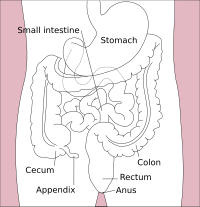
Photo from wikipedia
&NA; In recent decades, cephalopods have been shown to have very high capacities to accumulate most trace elements, regardless of whether they are essential (e.g., Cu and Zn) or non‐essential… Click to show full abstract
&NA; In recent decades, cephalopods have been shown to have very high capacities to accumulate most trace elements, regardless of whether they are essential (e.g., Cu and Zn) or non‐essential (e.g., Ag and Cd). Among the different pathways of exposure to trace elements, the trophic pathway appears to be the major route of assimilation for numerous metals, including Cd, Co, Hg and Zn. Once assimilated, trace elements are distributed in the organism, accumulating in storage organs. The digestive gland is the main organ in which many trace elements accumulate, whichever of the exposure pathway. For example, this organ can present Cd concentrations reaching hundreds to thousands of ppm for some species, even though the digestive gland represents only a small proportion of the total mass of the animal. Such a specific organotropism towards the digestive gland of both essential and non‐essential elements, regardless of the exposure pathway, poses the question of the detoxification processes evolved by cephalopods in order to sustain these high concentrations. This paper reviews the current knowledge on the bioaccumulation of trace elements in cephalopods, the differences in pharmaco‐dynamics between organs and tissues, and the detoxification processes they use to counteract trace element toxicity. A peculiar focus has been done on the bioaccumulation within the digestive gland by investigating the subcellular locations of trace elements and their protein ligands. HighlightsThe paper reviews existing knowledge on the metal metabolism in cephalopod.The bioaccumulation pathways, tissue and subcellular distribution are discussed.A peculiar focus is done on Cd and Hg.The paper highlights the gap of knowledge for these organisms of growing interest.
Journal Title: Environmental Research
Year Published: 2017
Link to full text (if available)
Share on Social Media: Sign Up to like & get
recommendations!